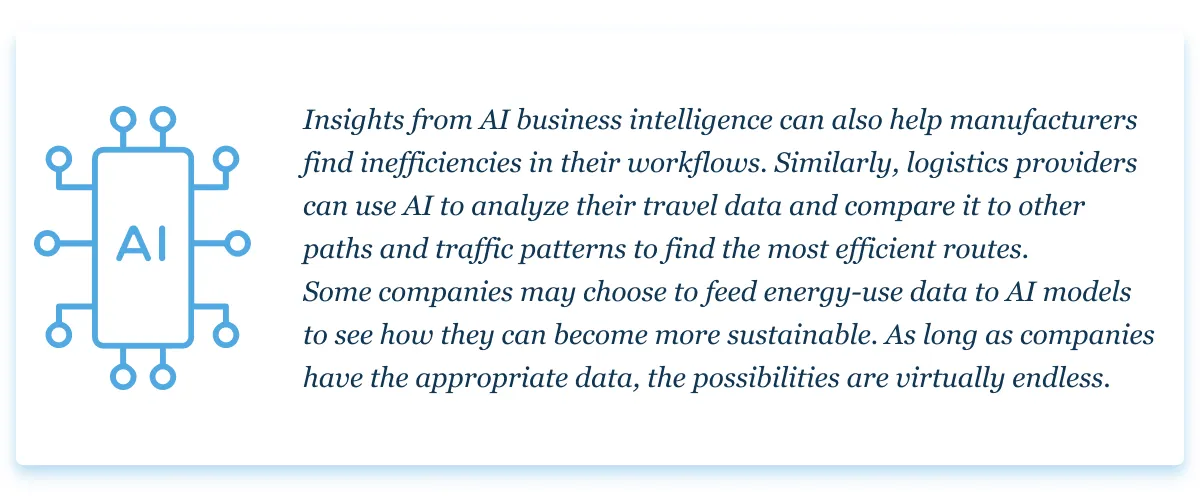Artificial intelligence (AI) is one of the most disruptive technologies businesses have ever had at their disposal. As consumer applications like ChatGPT skyrocket, the possibilities of AI integration in business are becoming increasingly clear.
The importance of AI for modern companies is growing. Organizations that don’t capitalize on AI may quickly fall behind their competitors that do, but this integration can be challenging if leaders don’t know where to begin. To integrate AI into your business, you must first understand what specifically it can do for you.
Applications for artificial intelligence in business
There are many AI applications in business, and new ones emerge frequently as this technology advances. Many of the most common use cases revolve around automating business processes to boost productivity or minimize errors. According to McKinsey, 39% of companies used robotics process automation (RPA) in at least one function, making it the most common AI application.
RPA automates routine digital tasks, such as data entry or scheduling. While that may seem simple, it can save businesses a considerable amount of time. Generative AI models can go further and automate things like drafting emails or responding to clients. As a result, AI marketing solutions can reach more people on a personalized level in less time than manual alternatives.

Source: Unsplash
In addition to automation, many businesses also use AI to analyze data. Machine learning models can spot trends in data faster and more accurately than humans. This analysis lets them offer actionable insights based on company data, even predicting future outcomes. Supply chain operations and marketing strategies, in particular, can benefit from the agility this foresight enables.
Benefits of AI in business
Since AI examples in business span such a wide range of applications, there are many ways for AI to benefit a business. Here’s a glance at some of the most common advantages of AI integration.
Efficiency
AI’s speed is one of its greatest strengths. In many areas, AI can act almost instantaneously where it may take humans several seconds or even minutes to hours. In low-sensitivity applications, that efficiency frees workers to focus on other tasks, and in high-sensitivity ones, it can prevent extensive losses.
Automating routine tasks with AI — one of the most common and simplest AI integration use cases — can improve efficiency by 30%-40%, letting workers accomplish far more in less time. In a more sensitive application, like responding to cyber threats, those savings are even more impactful. AI can identify suspicious activity and isolate the suspicious user or application immediately, preventing costly data breaches.
Data insights
Another leading benefit of integrated AI is that it can pull insights from data businesses may otherwise miss. E-commerce sites can build predictive analytics models to learn from past seasonal shifts to predict future demand fluctuations. They can then prepare sales and adjust inventory levels to prevent stock-outs or surpluses before buying habits change.

Error reduction
AI applications in business can also prevent costly mistakes. Humans aren’t well-suited for repetitive, data-heavy tasks, as they can easily get bored, distracted or tired, leading to errors. However, these workflows are exactly where AI excels. Consequently, automating this kind of work through AI will make mistakes far less likely, leading to time and cost savings.
Even experienced employees can make mistakes, and correcting even minor errors can take hours out of the work week. In some industries, data mistakes can cost more than time, as they may result in lost business, financial errors or misdirected strategic decisions. That makes AI in corporate finance and similar sectors a highly competitive advantage.
Adaptability
Artificial intelligence integration can also enable a business to become more adaptable. Conventional automation offers similar efficiency benefits but tends only to work well when conditions are constant and predictable. AI, by contrast, can analyze and adjust to changes in incoming data because it’s always learning.
Personalization is one of the most impactful benefits of that adaptability. Business AI solutions can tailor outreach messages or chatbot personalities and responses to individual users based on their needs and expectations. By adapting to each person’s unique situation, these technologies offer better customer experiences and more relevant help, increasing client loyalty.
Challenges of AI in business
Like any technology integration in business, AI projects come with some limitations and challenges. An effective artificial intelligence strategy takes these obstacles into account to minimize their impact and enable higher returns on investment.
Cost and complexity
Nearly a third of companies cited high prices as a barrier to their AI integration. Another 34% said they had limited AI skills or experience, making it difficult to implement this technology because it can be complex. These financial and complexity challenges are closely intertwined, as unexpected hiccups in AI development and implementation tend to increase project costs.

Source: Unsplash
How much artificial intelligence integration costs varies widely depending on the scope of the project and the specific technology at hand. Many businesses approach this technology out of excitement without a clear understanding or goal, so the project ends up costing more than expected.
The inability to deal with AI’s complexity exacerbates these costs. Working with a reliable AI consulting service can prevent these obstacles, but many companies overlook that need.
Ethical questions
As AI technology companies have become more prominent, ethical concerns around AI have also risen. Many of these questions revolve around AI’s ability to outcompete humans in some roles. A recent survey found that 24% of workers today are worried AI will make their jobs obsolete, with some industries seeing double that rate of concern.
Some people also fear that unchecked AI advancement could lead to a loss of human touch and reasoning. If that happens, AI could exaggerate innate human biases, harming historically oppressed groups before businesses recognize the issue. Generative AI also introduces questions around copyright infringement, as it may produce creative works based on unlicensed training data.
Data problems
Digital artificial intelligence platforms also require a lot of data. Those vast data requirements can make the technology inaccessible for companies without sufficient resources to store and manage it. Collecting that information can also introduce concerns about privacy and security.
Business AI applications may gather more user data than companies realize or use it in ways they didn’t know. As a result, it may lead to accidental privacy violations or unknowingly put sensitive information at risk of a data breach. As data security laws and their accompanying fines grow, those possibilities carry greater financial and regulatory weight.
How to integrate AI into a business
In light of these concerns, organizations shouldn’t take AI integration lightly. If you want to integrate AI into your business, you must keep these challenges in mind as you approach this technology. Follow these five steps to account for AI’s obstacles and maximize its potential.
-
Identify a clear use case
The first step to successfully integrate AI is to outline a specific application for it. Many AI projects fail, take too long or go over budget because they lack vision. Deciding on a specific, relevant use case before investing in anything prevents those outcomes.
Start by comparing modern AI solutions’ capabilities to parts of the business that need improvement. Repetitive, data-heavy tasks are often the best-suited for AI, and some companies have saved 15,000 employee hours per year by automating things like invoicing. Workflows with high error rates are also good places to start.
-
Determine your budget and AI capabilities
Next, compare this use case to available AI solutions. Review company financials with these options in mind to determine a clear AI budget, which will help prevent overspending.
Using AI in business effectively also means recognizing what it takes to build or deploy these models. Many companies lack the internal expertise to create their own AI, making off-the-shelf solutions a better option. Keep in mind that it may be possible to foster AI talent from within. Nearly half of all job-seekers are interested in AI, so upskilling them to manage AI could be an option.
-
Set goals
Successful AI technology companies also set clear expectations and performance targets for their AI projects. To do that, measure current key performance indicators (KPIs) for the business processes AI will automate or otherwise impact.

Source: Unsplash
After setting a baseline, set performance goals for post-implementation. These targets will make it easier to build an effective, results-driving AI solution and keep the project on track. Without them, AI integration may run behind schedule and it’ll be hard to judge its success.
-
Build or deploy the model
After setting budgets, project goals and specific use cases, it’s time to choose an AI solution. There are two main approaches businesses can take here: using an off-the-shelf AI product or building a proprietary AI system.
Ready-made business AI systems are often more affordable and easier to deploy, making them ideal for smaller companies or those with minimal AI experience. In contrast, custom solutions may cost more and require more expertise, but they can deliver better results, especially for companies with unique needs. Working with third-party experts can also offload some of the AI software development burden, so extensive AI experience isn’t necessarily a must-have.
Whichever path a company takes, it should prioritize data privacy and security from the start. Teams should also review integrated AI models to ensure they don’t exhibit bias or introduce risks from copyright infringement or other ethical concerns. Third-party audits can provide that assurance.
-
Monitor AI outcomes closely
Finally, after businesses deploy their AI solutions, they should keep a close eye on them. Start by applying AI to a single, specific purpose and only expand it once returns start coming. This slower, more careful approach eases the financial burden and enables a more effective rollout. Monitor the same KPIs you used to set performance benchmarks. How the AI application measures up to these goals will inform future investments by revealing what worked and what could’ve been better.
Artificial intelligence integration is crucial for modern businesses
Artificial intelligence integration is becoming increasingly important as more businesses embrace this technology. As it grows, AI will transform businesses for good. Well-planned, thoughtful business and AI integration will prepare a company for the future. They can then serve client needs better, work faster, reduce costly errors and become more adaptable.
Author bio
April Miller is a senior writer with more than 3 years of experience writing on AI and ML topics.



